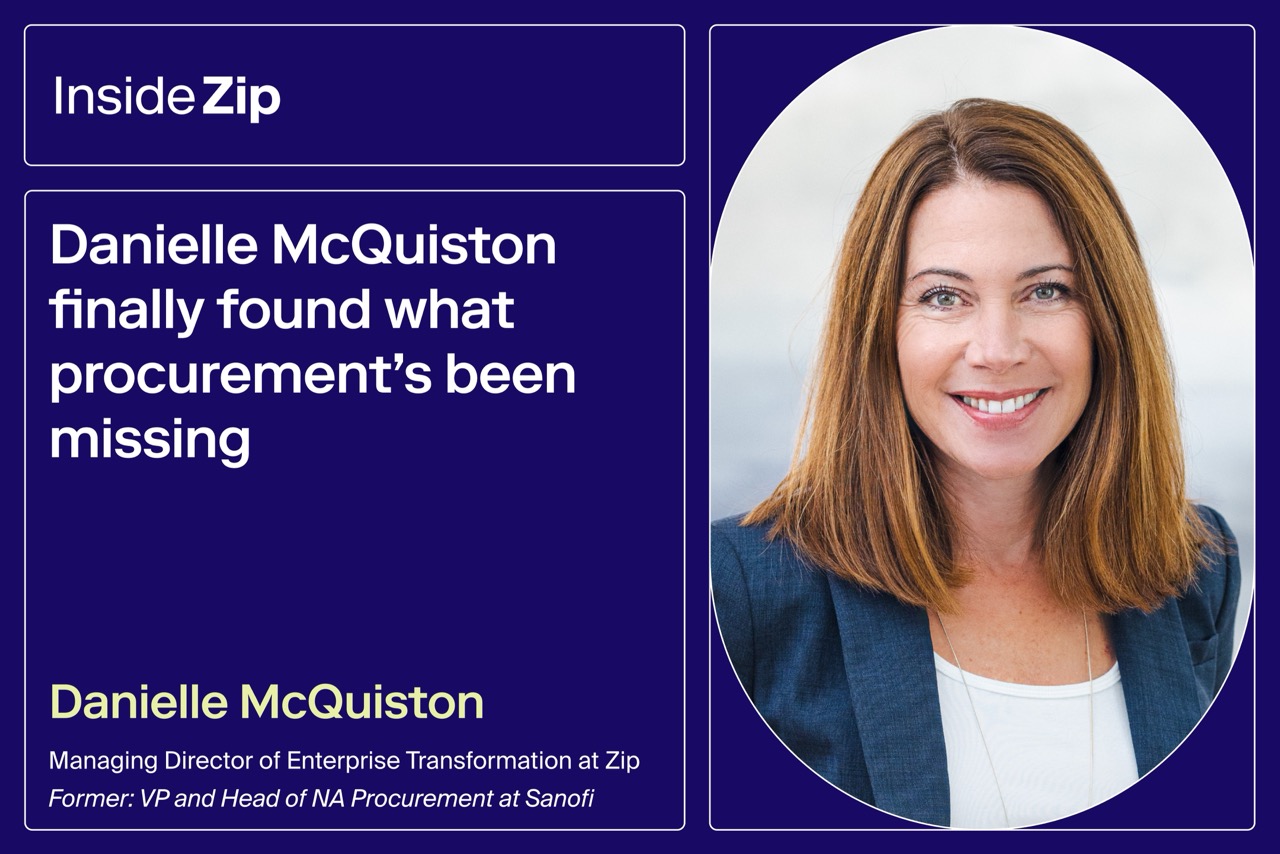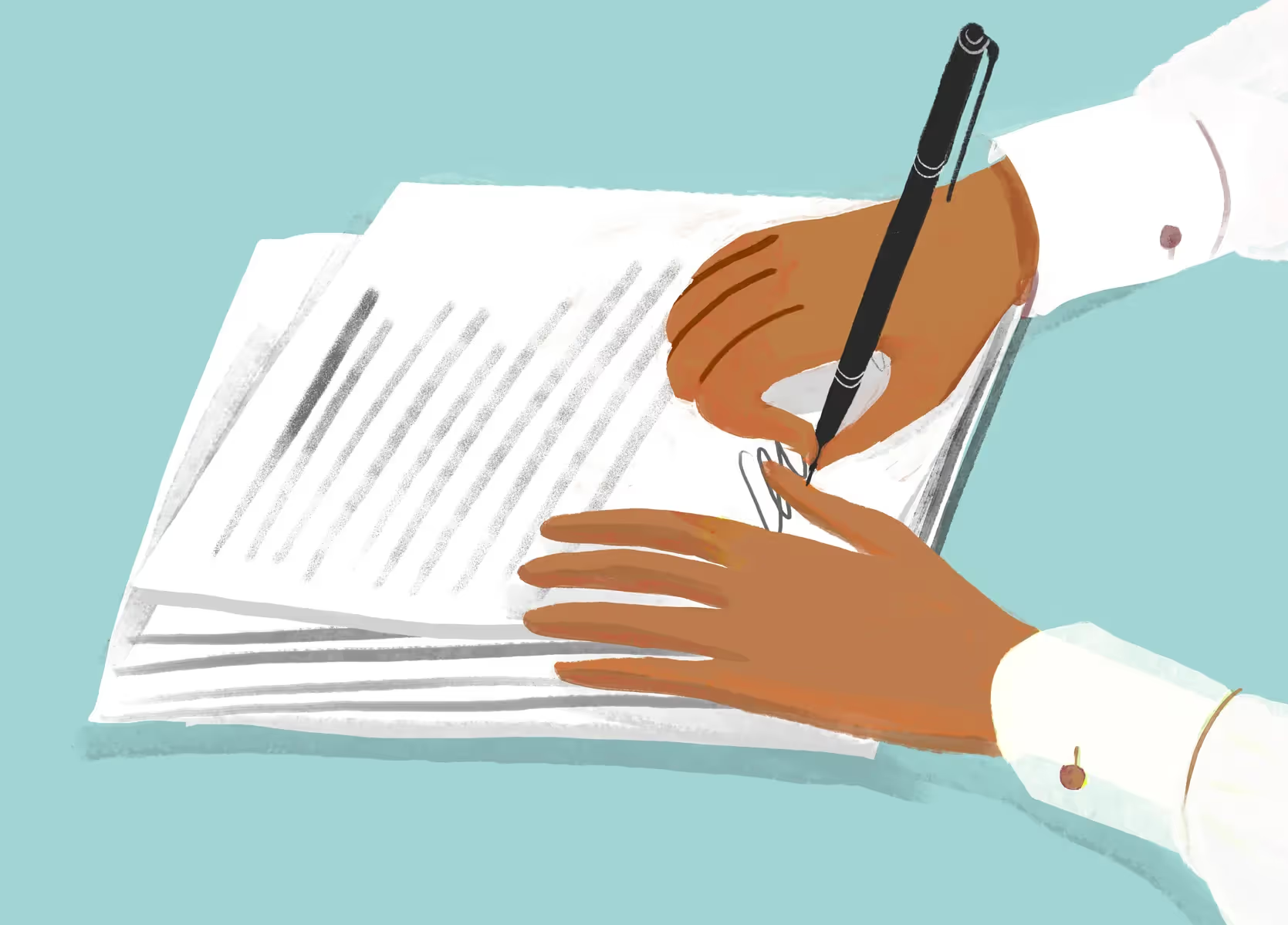
Purchasing process: Steps and best practices
Learn the steps of the purchasing process, and best practices in Zip.

Everyone knows how to make a purchase—you decide what you want and swipe your credit card. It’s that easy, right?
In business, things are a bit more complex. Before even considering payment, you’ve got to deeply understand the business need for a good or service, fill out forms to submit internally and to your vendors, receive layers of approvals from stakeholders at your company, and consider the fine details of contracts—all before your proverbial card ever leaves your proverbial wallet.
Indeed, all of these activities contribute significantly to the final mark on your company’s bottom line. For this reason, understanding and optimizing the purchasing process is absolutely essential for organizations looking to improve efficiency, reduce costs, and streamline procurement operations.
Fortunately, the team behind the procurement orchestration platform Zip is here to offer insights and solutions that transform the purchasing process into a strategic advantage.
Let's explore the purchasing process steps, challenges, best practices, and the significant benefits of investing in your purchasing process with Zip's AI-powered solutions.
What is the Purchasing Process?
The purchasing process is a key component of the broader procurement process, involving the specific steps an organization takes to identify, select, and acquire goods and services. It starts from the recognition of a need and ends with the payment and reconciliation of invoices. This process ensures that businesses can meet their operational requirements efficiently and cost-effectively.
9 steps of the purchasing process
Navigating the purchasing process efficiently is crucial for businesses to ensure they acquire goods and services in a timely, cost-effective manner. This process, consisting of several key stages, involves everything from identifying the need for a product or service to paying the vendor and updating accounting records. Understanding each step in detail can help organizations streamline their purchasing activities, reduce expenses, and optimize operational efficiency. Let's delve into the nine essential steps of the purchasing process.
1. Define the Need
The purchasing process begins when an organization identifies a need for goods, tools, or services. This initial step requires a thorough assessment of what is required, the quantity needed, and the timeline for acquisition. It's critical for businesses to accurately define their needs to avoid over or under-purchasing, ensuring that resources are allocated efficiently.
2. Create a Purchase Requisition
Once the need is clearly defined, the next step is to fill out and submit a purchase requisition to the procurement department or directly to a purchasing manager. This document should detail the specific goods or services required, including quantities, specifications, and the desired delivery timeline. The purchase requisition acts as a formal request to kick-start the purchasing process.
3. Review and Approval of Purchase Order (PO)
Following the approval of the purchase requisition, a purchase order (PO) is generated. This document formalizes the intent to buy the specified goods or services from a vendor, outlining the types, quantities, and agreed-upon prices. The procurement team must ensure that all details on the PO accurately reflect the approved purchase requisition before proceeding.
For more information on these steps, see our recent article: ‘Purchase Requisition vs Purchase Order: Understanding the Difference for a Streamlined Procurement Process’.
4. Request for Proposal (RFP) or Request for Quotation (RFQ)
With an approved purchase order in hand, the procurement department may issue a Request for Proposal (RFP) or Request for Quotation (RFQ) to potential vendors.
These documents are used to solicit bids for the goods or services needed, allowing the organization to compare prices, terms, and quality before selecting a vendor.
5. Finalize Contracts
After selecting a vendor based on the RFP or RFQ responses, the next step is to negotiate and finalize a contract. This legally binding agreement outlines the terms and conditions of the purchase, including pricing, delivery expectations, and any other relevant details. Both parties must agree to and sign the contract before any goods or services are exchanged.
6. Review Vendor Performance
Upon delivery of the goods or completion of the service, it's important to review the vendor's performance against the contract's specifications. This step is where you want to identify any discrepancies or issues that need to be addressed and serves as a record for future purchasing decisions.
7. Three-way matching
Three-way matching is a critical step in the purchasing process that involves comparing the purchase order, the delivery receipt, and the vendor's invoice to ensure consistency across all documents.
This verification process helps prevent payment errors and fraud by ensuring that only goods and services actually received and agreed upon are paid for.
8. Approve the Invoice and Pay
After verifying that the invoice matches the purchase order and delivery receipt through three-way matching, the invoice can be approved for payment. Prompt payment ensures a good relationship with vendors and may qualify the business for discounts or better terms in the future.
9. Update Accounting Records
The final step in the purchasing process is to update the organization's accounting records. This includes recording the purchase details, payment information, and any adjustments necessary to reflect the transaction accurately. Maintaining accurate and up-to-date financial records is essential for effective budgeting and financial planning.
Purchasing process vs. procurement process
In the standard operations of business, the terms ‘purchasing’ and ‘procurement’ are often used interchangeably. However, they refer to distinct processes with their own set of objectives and activities.
The purchasing process is a subset of the broader procurement process, focusing specifically on the transactional phase we specified above—the operational aspects of obtaining what is necessary to run the business.
In contrast, the procurement process encompasses a much wider range of activities than purchasing. While there is certainly overlap, the procurement process includes:
- Identifying the overall needs of an organization
- Evaluating and selecting vendors, potentially based on long-term criteria
- Negotiating contracts
- Managing relationships with suppliers
- Strategic sourcing
- Ensuring compliance with company policies and external regulations
- Continuously seeking cost-saving and efficiency improvement opportunities
Procurement is strategic in nature, focusing on long-term planning and relationship-building necessary to secure the best possible value for the organization, whereas the purchasing process is the actual transaction flow to determine how to best acquire goods and services.
Common challenges to the purchasing process
While businesses of any size can excel in ensuring a successful purchasing process, there are a range of challenges that, if not properly managed, can grow alongside the business.
At the heart of many challenges to purchasing is the over-reliance on manual systems. Particularly for growing businesses, sticking with manual operations—paper-based orders, spreadsheet tracking, hand-signed approvals, etc.—can quickly become a bottleneck. Manual systems not only slow down the purchasing cycle, but can increase the risk of errors and inefficiencies, and hinder a company’s ability to scale effectively.
Some other challenges to watch out for:
Human Error
One of the inevitable aspects of manual purchasing processes is human error. As the complexity and volume of transactions increase with business growth, so does the likelihood of mistakes.
Automated digital systems can dramatically reduce errors like incorrect data entry and other missed details, with automated checks and balances that can flag discrepancies before they become a problem.
Approval and workflow delays
Particularly in a manual purchasing environment, approval and workflow delays are common roadblocks. Without streamlined communication and collaboration tools, teams can succumb to missed deadlines and delayed projects.
Implementing automated workflows not only ensures all parties are aware of their responsibilities and timelines, but can also accelerate the approval process, keeping operations on track.
Siloed teams
Another significant challenge is the isolation of teams or departments within an organization, each operating in its own bubble. This siloed approach can result in miscommunication and missed opportunities for synergy, particularly in the purchasing process.
A digitized system fosters collaboration by providing a unified platform where all stakeholders can interact, share information, and work together more effectively.
Overall inefficiency
Finally, the inefficiency of a non-standardized purchasing process cannot be overstated. Without automation, it's challenging to maintain visibility over the entire process, from requisition to payment. This lack of oversight can lead to missed cost-saving opportunities and a failure to leverage economies of scale.
Solutions like Zip streamline the purchasing process, offering real-time insights into spending patterns, supplier performance, and potential areas for improvement.
Purchasing process best practices
The purchasing process is a vital component of a company’s operations, directly impacting financial health and operational efficiency. By adopting some best practices in the purchasing process, businesses can realize significant benefits, from cost savings to supplier relationships.
Here are some purchasing process best practices we recommend here at Zip.
Embrace automation
One of the most transformative moves you can make is to find ways to automate the purchasing process.
Automation replaces manual, time-consuming tasks with efficient, digital workflows, freeing up employees to focus on more strategic, value-added activities. This shift not only speeds up the purchasing cycle but also reduces the likelihood of errors associated with manual data entry and processing.
Strengthen vendor relations
The strength of a company's relationship with its vendors can significantly influence its purchasing effectiveness. Best practices in the purchasing process emphasize the importance of fostering strong, collaborative relationships with key suppliers.
You can use vendor management software to simplify regular communication, which can encourage transparent negotiations and other mutually beneficial agreements.
By prioritizing strong vendor relations, businesses can ensure a reliable supply chain and gain access to competitive pricing, ultimately improving the quality of goods and services received both during the purchasing process itself, and well into the future
Standardize the procurement process
Standardization of the procurement process is another highly suggested best practice.
By establishing clear, consistent procedures and criteria for purchasing activities, businesses can streamline operations, reduce employee confusion, which will help to ensure compliance with internal policies and external regulations.
Standardization enhances the efficiency of the purchasing process by making it easier for employees to understand and follow the established workflows and for management to monitor compliance and performance.
If procurement and purchasing is ‘hard’, employees are less likely to follow the rules!
Track and analyze purchasing data
This being the 21st century, data plays an increasingly essential role in optimizing the purchasing process.
Tracking and analyzing purchasing data allows businesses to gain insights into their spending patterns, identify opportunities for cost savings, and make informed decisions about vendor selection and contract negotiations.
By using Zip to increase visibility and provide insights on company KPIs, your business can easily assess purchasing efficiency, effectiveness, and adherence to budgets, enabling continuous improvement in procurement activities.
Why you should invest in your purchasing process
As we’ve discussed, the efficiency and effectiveness of your purchasing process can significantly impact your bottom line.
Investing in modernizing your purchasing process through standardization, automation, and strategic planning offers a multitude of benefits that can transform operations:
Ensure cost-savings
One of the most compelling reasons to invest in your purchasing process is the potential for significant cost savings.
A standardized, automated purchasing system streamlines operations, reducing the risk of overbuying or investing in unnecessary goods and services. It allows businesses to analyze spending patterns, negotiate better deals with potential suppliers, and ensure that every purchase is justifiable and adds value to the organization.
By minimizing wasteful spending, companies can allocate resources more efficiently and boost their financial health.
Streamline the purchasing workflow
A modernized purchasing process eliminates bottlenecks and inefficiencies, ensuring a smooth workflow from requisition to payment. Automating the approval chain accelerates decision-making, reduces paperwork, and minimizes the risk of errors or miscommunications.
This streamlined approach not only speeds up the purchasing cycle but also enhances the overall productivity of your team, allowing them to focus on strategic tasks rather than administrative duties.
Improve vendor relationships
Having clear, standardized purchasing documents and processes set the stage for transparent and effective interactions with your vendors. Focusing on clarity in communication and collaboration helps in building trust and strengthening relationships with suppliers, which can lead to better pricing, improved quality of goods and services, and more favorable terms.
Strong vendor relationships are crucial for ensuring a stable and reliable supply chain, essential for your business's success.
Decrease procurement management risk
A well-structured purchasing process significantly reduces the risks associated with procurement management. By implementing checks and balances, such as approval workflows and spending limits, businesses can avoid unnecessary purchases and non-competitive pricing.
Automation further minimizes the chance of human errors, ensuring compliance with company policies and industry regulations. This proactive approach to risk management safeguards the company from financial pitfalls and operational disruptions.
Easily scale and grow with time
Finally, a modernized purchasing process is scalable, designed to grow with your business.
As your company expands, the complexity of your purchasing needs will increase. An automated and flexible system can easily accommodate additional approval levels, new categories of spending, and cross-functional collaboration without significant restructuring.
This scalability is vital for businesses looking to grow without being hampered by outdated or inflexible processes.
Going from purchasing process to procurement orchestration
Business operations are constantly evolving, and the transition from traditional purchasing processes to procurement orchestration represents a significant leap towards efficiency, collaboration, and strategic procurement management.
Procurement orchestration is a sophisticated approach that centralizes all purchase intake requests and coordinates the required cross-functional approvals to create a purchase requisition. This process not only simplifies the procurement workflow but also ensures that all necessary stakeholders are involved in the decision-making process from the outset.
One of the most significant advantages of procurement orchestration is the addition of a collaboration layer to the procurement process.
This layer is crucial for increasing stakeholder adoption by ensuring that all relevant parties are engaged and informed throughout the purchasing journey.
According to research conducted by Zip, nearly half of over 1,000 businesses surveyed indicated that they require six cross-functional approvals for new software or vendor purchases. This research underscores the complexity and necessity of collaboration in modern procurement practices.
There are several ways procurement orchestration can streamline intake and approvals across business, through several key mechanisms.
- Automated Workflows and Processes: Automation plays a pivotal role in procurement orchestration, eliminating manual tasks and reducing the potential for errors. By automating the workflow, businesses can ensure a smooth, efficient process from the initial request to the final approval, significantly cutting down on processing time.
- Process Reporting and Analytics: With procurement orchestration, organizations have access to detailed reporting and analytics, providing valuable insights into the procurement process.
- Single Front Door for Intake: Zip’s orchestration platform all starts with a ‘single front door’ approach to managing purchase requests, centralizing intake and ensuring that all requests are processed through a uniform, streamlined procedure. This not only simplifies the process for requesters but also enables better control and oversight for procurement teams.
The shift from traditional purchasing processes to procurement orchestration represents a strategic evolution in how businesses approach procurement.
By centralizing intake requests, coordinating cross-functional approvals, and leveraging automation, procurement orchestration offers a pathway to more collaborative, efficient, and strategic procurement practices.
Zip’s AI-powered purchasing process solutions
Zip offers cutting-edge AI-powered solutions to streamline the purchasing process— from automating manual tasks to providing comprehensive spend insights in real time, analyzing vast quantities of vendor data to help you and your teams make better decisions.
With Zip's complete procurement orchestration platform, your teams can easily navigate the complexities of the purchasing process, ensuring a streamlined, cost-effective approach that supports your strategic goals.
Ready to elevate your purchasing process? Request a demo with Zip today and discover how our procurement solutions can transform your organization's purchasing strategy for the better.

Maximize the ROI of your business spend

Enter your business email to keep reading



























.webp)




















.avif)












.avif)










.webp)





.avif)












.avif)
